Swirl Baby Swirl
Sunday, November 13th, 200512 November 2005 (Saturday) – La Paz to Cochabamba, Bolivia
Alexis met me in front of the Iglesia San Francisco at Plaza San Francisco and whizzed me to Plaza Villarroel by bus. There was the institute where he works. The school organizers had set up tables, chairs, red and white balloons, so everywhere had quite a school-festive mood.
Alexis’ family soon arrived… his girlfriend, sisters, mother, aunt and cousin.

Soon, the performances started, there were all the various Bolivian traditional dances from different regions like Tinku, Morenada, Caporales, Chacarera, Potolos, Cullauda, Tobas… OK, these dances were performed by teenagers from the institute and frankly, most of them were rather bad, lacking any enthusiasm or energy. But, for me, it was really interesting to see all the exaggerated, colourful, sequined costumes, hats and masks.


I recalled Peru’s traditional dances performed at the La Candelaria restaurant and realised the world of differences!
Alexis’ mother and aunt were very sweet, quick to explain to me what each of the dances meant. Several of the dances represent masters and slaves during the colonial period (Morenada), or fights between groups over a woman or territory (Tinku), or dances for yarn-spinners (Cullauda) or for people who work with cows (Waca-Waca).
You would also often see a couple of svelte (or perhaps, not so) women in very short skirts and matching hats, doing their little sexy swirls, showing off their panties. When I asked Alexis what these women represent. He pondered for a moment before concluding they were just ornaments. But hey, these ornaments are truly symbols of Bolivian traditional dances as they often grace tourist posters and such.
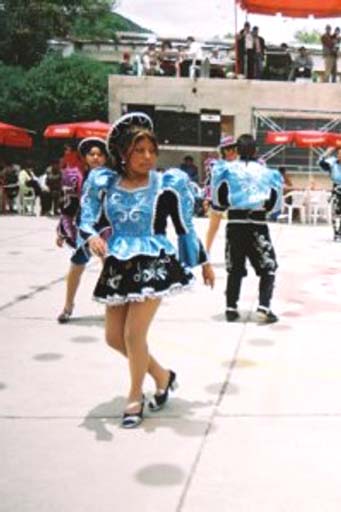
The other famous dance must be Morenada where men wore what look like layers of lamp-shades with intricate threadings of sequined tassels and pearls, and topped with a scary mask. Alexis told me a good costume like this might cost up to US$1,500!!
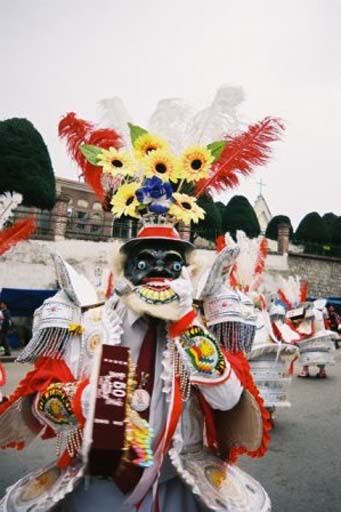
Oh, the whole family actually felt a little embarrassed by the mediocre performances of the students, insisting that I ought to go to the Carnaval of Oruro to see the best of Bolivian dances. Hahaa, let’s see if the Bolivian Embassy approves my visa application again.
When we returned to town, Alexis told me there was actually a public dance procession going on now, near the Cemetery. It was the Anniversary of the Association of ‘Comerciantes’. The comerciantes are the street-vendors. I had mentioned that the entire La Paz is a street market, right? Sure, there are street markets in every city, but La Paz must the great grandmother of such cities!
These street vendors form unions based on the products they sell, and are controlled and organised by leaders. The number is so huge that the vendors are actually a very powerful political group. Geee… I never thought of them in that way. I just thought of them as poor dears who had to work on the streets selling things that everyone else is selling and wondered how in the world they could make a living.
Before, the residents of La Paz used to complain about the sheer number of street vendors. They dirty the streets with the rubbish, they make a lot of noise, they set up their stalls on both sides of the pavements making it impossible to walk, they sometimes even set up on the road itself, making driving dangerous, they block the entrances to all the legitimate shops which pay taxes… But as they are so many and so powerful, the vendors themselves defended themselves, protesting that they are very poor and this is the only way to make a living, hence, there was nothing the authorities could do to remove them.
And while they claim to be very poor, they sure have the budget to set aside to buy some amazing costumes, accessories and some serious loads of beer to do the procession today.
For each union, for example… I saw the flags for the union of those who sell cloth and of those who sell ‘various articles’ (hmmm… combs, nail-clippers?), there was a band making a lot of awful music. The ‘attractive’ pear-shaped cholas were dressed in coordinated outfits – the multi-layered flouncy polleras (skirts), the bowler hats, many of which were pinned with gold ornaments, and the absolutely gorgeous intricately-embroidered shawls. No way these outfits were scantily put together from crappy cheapskate materials. Each of them were sewn with a lot of care and hard work, using excellent materials. I tell you, these were some very expensive costumes!!! These cholas did their coordinated swirls, to the music, making it quite a pretty sight to see the long skirts swirling across the street.
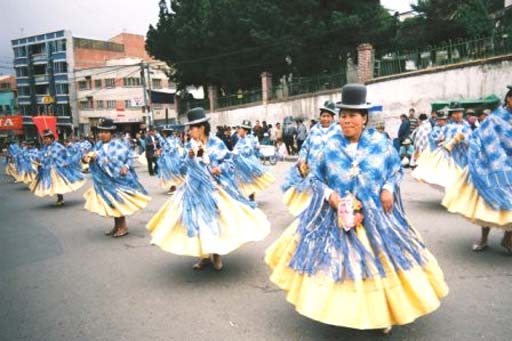
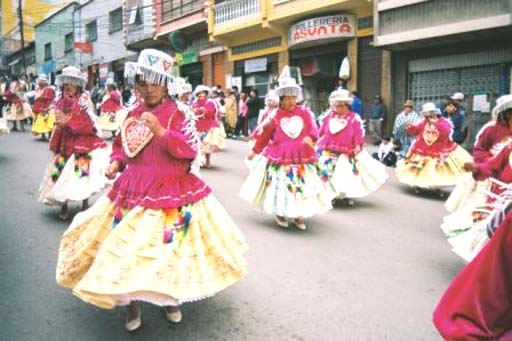
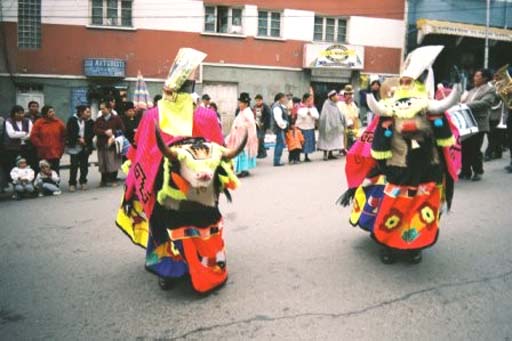
Of course, no one can forget the ornamental girls… usually, very young and svelt, in the short skirts and cute hats, doing the same swirls, but cute little swirls because of the extreme shortness of the skirts.
Several groups stopped to rest, and they gutted down cans and bottles of beer, getting more and more pissed-drunk as the day wore on.
We even passed by some people perched on a stage watching the procession. I asked Alexis who they were. He explained they were the leaders of the unions who organise the street vendors. Oh, the mafia…
That night, I finally left La Paz on the night bus. A little sad to say good-bye to La Paz which had been mighty interesting and eye-opening to me. As the bus drove to the top of the basin at El Alto, gosh… La Paz looked absolutely pretty, like a gigantic basin-shaped Christmas tree with the twinkling white and orange lights.
